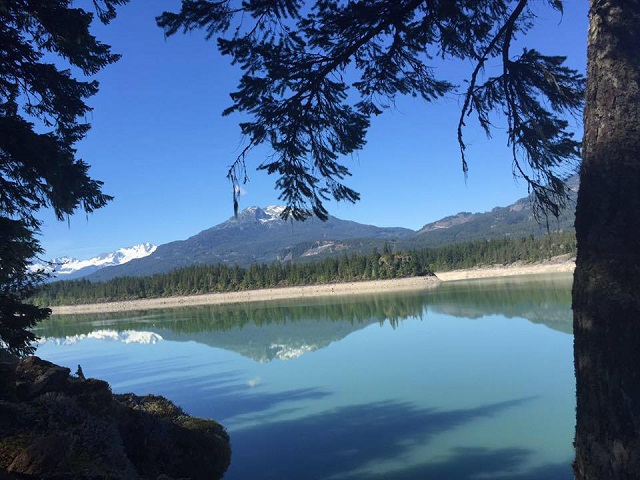
A few months ago, I decided to sign up for a week-long silent meditation retreat.
Everyone I spoke to who had done one said it was a worthwhile experience, although none of them went into much detail about what they experienced themselves.
After doing a few weekend-long, non-residential retreats—and really liking them—I felt ready to take on the full experience. The fact that it took place during a bright summer week by a crystal blue lake in beautiful BC helped with the decision.
So I packed up my bench, cushion, and some clothes, and headed on my way.
As I turned off the Sea to Sky highway onto the private gravel road leading to the retreat centre, the feeling of slight trepidation I’d had earlier was turning into full-blown terror. What was I doing here? I had no business being here. I don’t know anyone. Everyone else has done this before.
I was close to turning around.
Instead, I drove up to the main house and met Carol, the retreat manager. She explained that I needed to sign up for a “yogi duty” and said if I was really keen, I could ring the gong at 5:30 a.m. I felt a shock wave roll through me as I contemplated getting up that early. I wrote my name beside “do dinner dishes,” and asked Carol where I should bring my things and park my car. I had brought flowers for the meditation hall, which I think balanced out my lack of enthusiasm for being the morning bell ringer.
I unpacked and headed back to the main house. I felt more relaxed already. Everyone was welcoming and interested in saying hello. Then Patti (who has gone on a three-month long retreat and been meditating for decades) approached me and said, “If we don’t talk again, have a good retreat.” I realized then that this enjoyable rapport would end immediately after orientation, when everyone would be observing the “noble silence.”
As I walked toward the meditation hall with the other 20-25 yogis, I heard a soft voice beside me ask if this was my first retreat. Enter Preet—a woman close in age to me, who I instantly felt a kinship with. “Yes,” I replied. “Me too.” I felt so grateful to have met someone who was as new to this as I was. As we took our shoes off before entering the hall, we both looked nervously at the daily schedule on the door: 5:30 a.m. bell, 6:15 a.m. sitting, 7:00 a.m. breakfast. Sitting. Walking. Sitting. Walking. “It’s all we do all day,” she whispered.
Don’t get me wrong, I knew this wouldn’t be like a spa retreat. The idealistic pictures you see in magazines showing people napping in hammocks or getting Swedish massages before entering a eucalyptus steam room (actually that sounds wonderful) are not what I was looking for. Having maintained a somewhat consistent meditation practice over the last year, I was ready for some serious meditating. But 5.5 hours of sitting and 3.5 hours of walking meditation each day? Yikes.
That night as I drifted off, I heard a train. There wasn’t a train for hundreds of miles though, and I realized then that my roommate was snoring. I am a light sleeper, but even ear plugs and two pillows over my head did not drown out the noise. I didn’t sleep a wink that night, and 5:30 a.m. came fast.
For anyone considering a retreat, it’s always a good idea to request a private room or note if you are a light sleeper. Sleeping arrangements can really make or break the experience.
I thought I would give it one more night in my existing room. I felt so tired I thought maybe I’d konk out and not hear the snoring. Not the case. That night it was so loud I grabbed my yoga mat and sheets and slept on the porch—with one eye open, as I kept thinking a bear was lurking nearby in the woods. I was exhausted and defeated. I texted my mom that morning to say I might be leaving that day.
After a bit of yoga and a sitting, I felt calmer and more relaxed. The problem seemed less monumental. I moved rooms that day. In the spirit of kindness and compassion, I left my old roommate a note explaining I’d moved to be closer to the hall. She was a nice lady.
Things bubble up when you meditate. Happiness, sadness, fear, anger, worry—everything.
Silence becomes deafening. Your body aches. You get bored. You long to be somewhere, anywhere else. You also have moments of total clarity. No thoughts, just peacefulness.
Also, that “thing” we all have. You know… that thing we all have that makes us uncomfortable. That we feel the most shame about. That thing we hide from the world. That thing definitely appears when you go on retreat. Maybe we didn’t even know that thing existed until we allowed ourselves to go deeply inward. That’s why people don’t like to be still—they don’t like what comes to the surface.
I recall one sitting, where I felt a sadness well up inside me about the broken relationship with my dad. I felt overcome with emotion. As tears rolled down my face, I just accepted it and felt it all. And then it passed. I felt light, energetic.
As I walked immediately after that sitting, I noticed nature in a way I never had before. The colours were brighter, more vivid. The sounds clearer and sweeter. Did I heal that wound? Maybe, maybe not. But it felt amazing to have released some pain in that moment.
In the Dharma talk that night, the teacher said sometimes you notice you’re being mindful when you feel like you’re doing it for the first time. It made so much sense, as I thought back to my nature walk earlier that day.
What is a Dharma talk? It was the hour we got to sit and listen to the meditation teachers talk about Buddhist philosophy, concepts of life, death, and their own personal experience. It was the best hour of the day (besides meal times). I looked forward to it each evening like I was going to watch my favourite show.
It should be noted that a lot of mindfulness is tied into Buddhism, and the meditation teachers all tend to be devout Buddhists. I am not affiliated with any religion, but am definitely spiritual. A lot of the concepts they talked about were so relatable and fascinating. The teachers were down to earth, wise and kind.
Now about those meals—all vegetarian. I love meat, but was open to a week without it. Ever since then, my relationship with meat has changed. Perhaps I will be a vegetarian one day, but at the time we were focused on practicing “mindful eating”: thinking with gratitude about where the food came from and the journey it made to get to our plate. The farmers, the transportation, the refrigeration, the cooks; and as you were eating, take in the colours, note the taste. Is it pleasant, unpleasant?
During a silent retreat, meal time is a daily highlight, whether we’re trying to be mindful or not. However, after day three, the same breakfast of rice porridge and oats and dinner of salad and dressing became repetitive. I was grateful for the cooks, but glad I kept snacks under my bed.
I also learned that walking meditation is not for me. It makes sense to really explore the mind/ body connection, to take your time with each step and appreciate each moment for what it is, rather than always thinking about the next step. But I find it incredibly difficult to walk that slowly, so I turned the walking meditation periods into hiking adventures. There were tons of trails in every direction, and gorgeous look out spots onto Daisy Lake.
As I hiked, got lost, and hiked again, childhood memories kept popping up. (This happened a lot during the whole week. As my mind relaxed, things came back that I had forgotten about.) I remembered all the games we would play in the woods as kids, so many fun summers spent camping with my cousins. Jumping into the lake of cold glacier water felt so nice on a sore body that needed to be woken up. Patti came down to the dock one day and jumped in. It was a highlight of the retreat. Seeing the sense of adventure in these people who were so much older than me was fun and inspiring.
Speaking of inspiration, there was one man there who was in the early stages of Parkinson’s. I watched him sit with it, with the shaking that he was powerless to control. I couldn’t imagine what that would be like, nor will I ever forget it. One man had recently found out his wife had cancer. Another woman had lost a child. To feel others pain so closely, and to sit with them, was an overwhelming privilege. It’s this pain that brings people back to their meditation cushion, time and time again. It was a humbling experience that woke me up to the world and people around me.
What else did I get out of this first meditation retreat? I found a resilience in myself, proof that I could do this and feel proud to have stuck it out.
Going inward is powerful, and this life-long journey is just the beginning.
Many meditation masters, those who have dedicated their lives to the practice, will tell you that they know absolutely nothing. But “why am I here?” is a question I feel is worth exploring for a lifetime.
We must stay humble, and never think we have it all figured out. As U2 so eloquently put it, “the more you see, the less you know.”
Author: Kirsten Warneboldt
Image: Author’s own; @elephantjournal on Instagram
Editor: Nicole Cameron






Read 0 comments and reply